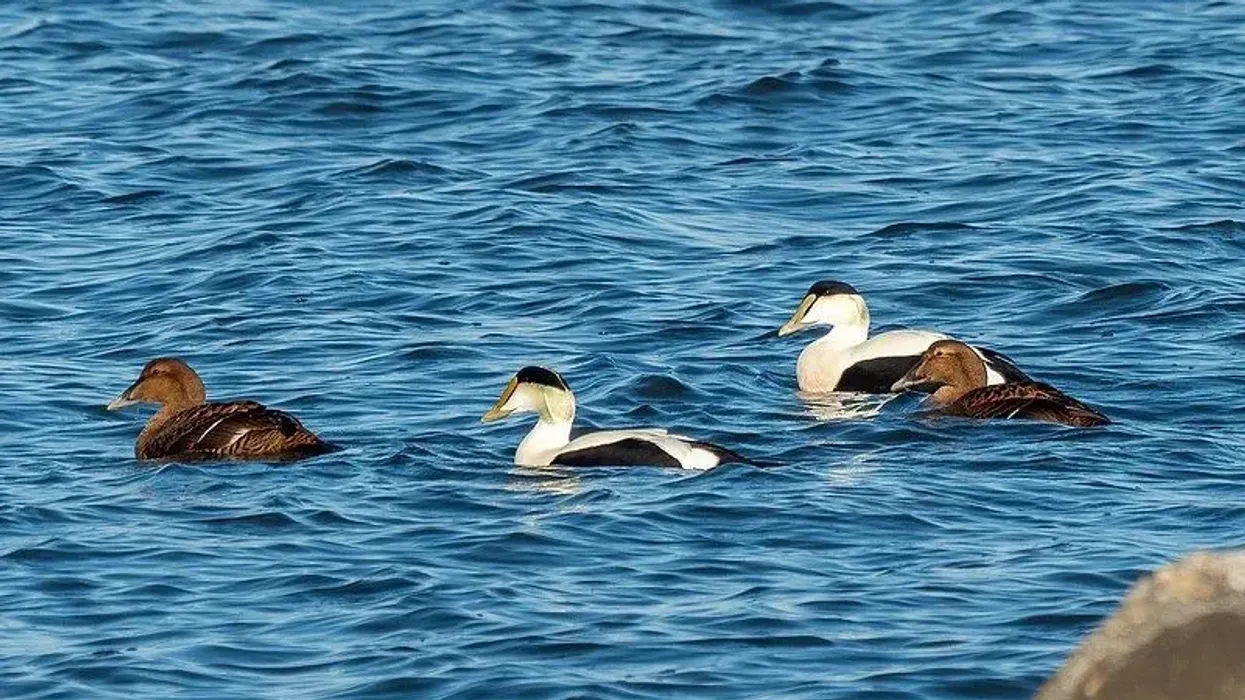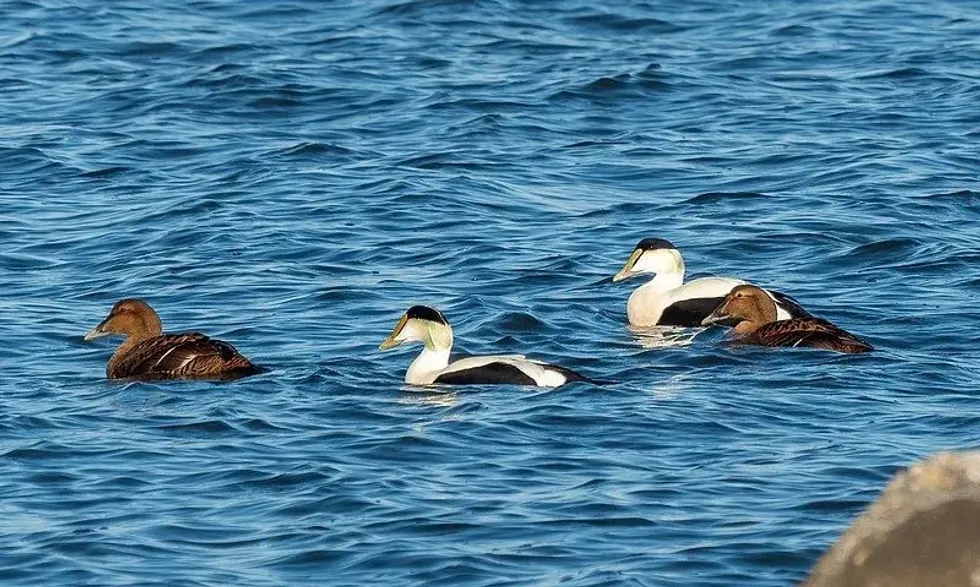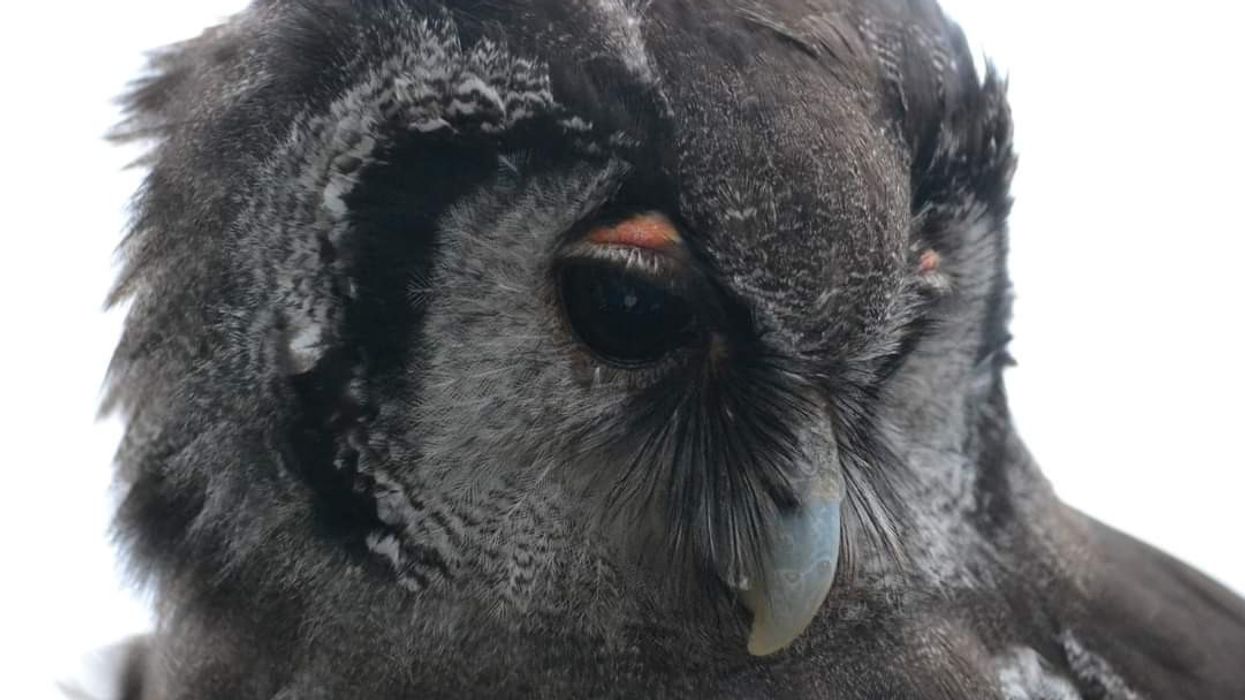Have you ever heard pleasant cooing calls along the rocky marine coastline on warm, quiet days? If yes, you might want to look out for a flock of sea ducks called the common eider.
This species' scientific name is Somateria mollissima, where 'somatos' means 'body', 'erion' means 'wool' in Ancient Greek, and 'mollissimus' means 'very soft' in Latin. Thus 'Somateria mollissima' is an apt name for this sea duck, as it means 'soft body wool'.
Common eiders are mainly found in the Northern Hemisphere where they breed. However, these birds fly farther south and nest along the marine coastline during winter. They built a nest with eiderdown plucked from the female breast. This eiderdown is harvested by humans for soft and warm lining duvets, pillows, and quilts.
The common eider gathers in large flocks along low rocky coastal lands surrounding the sea, mainly in Europe, North America, and the arctic regions of Canada, Hudson Bay, and Siberia. If you are a bird fan, you might like to check out our eared grebe and laughing gull facts on Kidadl too!
Common Eider Interesting Facts
What type of animal is a common eider?
In the Northern Hemisphere, common eiders are the largest sea ducks. These birds are migratory and are seasonal breeders. The eider belongs to the duck and geese family.
What class of animal does a common eider belong to?
The common eider is classified in the Aves class and placed under the family Anatidae in the group of Mergini/Somateriini.
How many common eiders are there in the world?
The common eider (Somateria mollissima) is abundantly populated with 1.5-2 million birds across North America and Europe. Its population size is unknown in Eastern Siberia. Nevertheless, they are very common and can often be seen floating offshore in flocks.
Where does a common eider live?
Common eiders are common in the far north but are rare in the south of the mid-Atlantic states. They are easily found in southern Alaska, Atlantic Canada, and New England.
Mostly they nest near rocky tundra coastline and they specifically nest in low-lying offshore islands, islets, coastal lagoons, skerries, and shoals to avoid predators. Their nest is hidden in tall grass, mosses, and small shrubs.
What is a common eider's habitat?
A common eider's suitable and preferred habitat is rocky coasts, skerries, shallow oceanic waters, and coastal lagoons (barren or forested) in tundra regions.
Who do common eiders live with?
Common eiders move in large groups. However, they co-habitat with marine seagulls and with small mammals living along the coastline, and they are friendly towards humans.
How long does a common eider live?
The average life span of the common eider is very high. It can live for 20 years long! Predators, starvation, or exposure to harsh conditions can kill young eiders, but an adult has excellent estimated survival rates, ranging from 80-95 %.
How do they reproduce?
Eiders do not have a mate for life. However, they are monogamous (they have one mate at a time). Male and female courtship is a long process through the breeding season and some do not pair until they reach the island.
During spring, the male common eider makes a display call to attract females. Females attain sexual maturity earlier than males. In early summer, the nesting period begins when the female builds the nest by plucking her down.
Once the nest is ready, the common eider hen lays between two and eight eggs on average. The eggs are incubated by the female hen alone, which lasts 25 days.
Young eiders are taken care of and protected for 30-50 days until their first flight. Common male eider flocks undertake ‘moult migration’ as the females begin incubating eggs. Hence, females take on the sole responsibility of raising ducklings.
What is their conservation status?
The common eider duck conservation status is listed as Near Threatened as populations of these ducks reduce drastically as a result of predators, human hunters, and extreme climatic conditions. Their nesting colonies are on the low-lying ground along the coastline, hence they are exposed to predators such as foxes, bears, snakes, ravens, and seagulls.
However, for birds that nest on small offshore islands, these predator attacks are significantly less.
Humans also hunt these birds for their down to make expensive insulating clothing and bedding. In response to this, many laws and treaties are now in place to protect these birds, and in many areas, hunting down is illegal.
Common Eider Fun Facts
What do common eiders look like?
Common eiders are large marine ducks and are North American birds. They have a heavy body, weighing 1.8-6.7 lb (0.81-3.04 kg).
An adult eider measures 20-28 in (50-71 cm) in length, and its wingspan ranges up to 31-43 in (78.7-109.2 cm). An adult eider exhibits sexual dimorphism and can be easily recognized by its color.
The breeding male common eider has a white body near the neck, a white breast, head, and back and a black crown, as well as black on the sides of its wings, belly, and tail.
They have an attractive green color on their nape with a gray-green, yellow, or orange bill. However, females are entirely different, with brownish-black barring and a gray bill.
Due to its color, the female can camouflage more easily with her surroundings from predators during the incubation period. Young common eiders also have a grayish-brown color and eventually grow up to look like their mature counterparts.

How cute are they?
Common eiders are colorful (the male has an attractive color pattern) and their young duckling is adorable!
How do they communicate?
This common sea duck lives in a flock and uses acoustic sounds to communicate. For example, the adult drake quacks a series of 'kor-korr' notes, and it can also produce a haunting call that sounds similar to pigeon cooing. This sound travels considerable distances on the water on still days.
Female ducks are less vocal than males. Instead, they produce a series of hoarse quacks during breeding and nesting and abrupt 'cluck-cluck' sounds while defending ducklings from predators. Ducklings produce several 'cluck' sounds, and they can produce high-pitched sounds and a monosyllabic piping sound as a distress call.
How big is a common eider?
The common eider measures 20-28 in (50-71 cm) which is five times bigger than North American birds such as the Carolina chickadee and the brown-headed nuthatch that grow up to a height of 3.9-4.3 in (9.9-10.9 cm).
How fast can a common eider fly?
Common eiders can be considered the fastest flying waterfowl, reaching 70 mph (112.7 kph). Most waterfowls can fly at a speed of 50 mph (80 kph), whereas ducks can fly up to 60 mph (96.6 kph).
How much does a common eider weigh?
The common eider weighs between 1.8-6.7 lb (0.81-3.04 kg). Males are larger than females.
What are the male and female names of the species?
A common eider male is referred to as a 'drake', whereas a common eider female is referred to as a 'hen'.
What would you call a baby common eider?
Young eiders are referred to as 'ducklings'.
What do they eat?
The common eider, Somateria mollissima, is piscivore and molluscivore. Common eiders feed on mollusks, crustaceans, mussels, clams, scallops, and urchins.
These species dive into marine waters up to 66 ft (20 m) deep, to find their food. These ducks eat mussels in their shell, which is crushed in the gizzard and excreted. However, eiders remove a crab's claws and legs before eating the crab's body.
Are they dangerous?
Both female and male common eiders are very sociable and quite approachable. However, they prey on small aquatic mollusks and crustaceans.
Would they make a good pet?
Common eiders are friendly and quite approachable birds that are often found in North America. However, they cannot be held in confined spaces. In addition, these ducks are migratory and have seasonal breeding and nesting requirements so cannot be kept as pets.
Did you know...
A 'drake' uses a strange human sound ('ah-ooo') for a display call and tosses its head upward to display its green color to attract a female bird.
Female eider birds undergo starvation during incubation. They leave the nest to drink water every two to five days but do not eat food.
Non-breeding females accompany fellow brooding hens to share the responsibility of the ducklings. This connection of non-brooding hens is referred to as 'aunt care'. Ducklings are gathered to form creches where it is easier for females to take care of groups and protect them from avian predators.
During nesting, mother ducks of this bird species poop on their eggs to protect them from predators.
Common eider king eider (S. spectabilis) hybridization can be seen in some areas.
You might wonder where eiderdown from this bird species is used. It is used to make expensive luxury insulating clothing and bedding.
Do common eiders dive?
Common eiders dive pretty impressively. This bird species has good eyesight and can spot its prey in deep marine waters.
Common eider breeding season
These North American birds return to their breeding islands early in the spring season as the shore's fast ice (or pack ice) starts to dissipate. Birds are paired when they arrive on the breeding grounds and courtship is intense in spring, when males make displays for females, including tossing their head up, cooing, neck stretching, and wing flapping.
Courtship continues after pairing until nesting. However, once females begin incubating eggs, the drakes undergo moult migration.
Here at Kidadl, we have carefully created lots of interesting family-friendly animal facts for everyone to discover! Learn more about some other birds from our blue-winged teal facts and limpkin facts pages.
You can even occupy yourself at home by coloring in one of our free printable common eider coloring pages.










